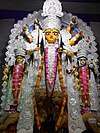Rasgulla
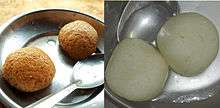 Pahala rasagolas from Odisha (left) and Bengali rasgullas (right) | |
| Alternative names | Rosogolla, rasagolla, rossogolla, roshogolla, rasagola, rasbhari or rasbari (Nepali) |
|---|---|
| Course | Dessert |
| Region or state | Bengal and Odisha |
| Serving temperature | Hot, cold, or room temperature |
| Main ingredients | Chhena, sugar |
| Variations | Bengali rosogolla, Odia rasagola |
| Similar dishes | Rasabali, Chhena gaja, Chhena poda, Ras malai, Komolabhog, Ledikeni, Pantua |
| Part of a series on |
| Bengalis |
|---|
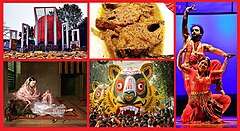 |
|
Bengali homeland |
|
Rasgulla is a syrupy dessert popular in the Indian subcontinent and regions with South Asian diaspora. It is made from ball-shaped dumplings of chhena (an Indian cottage cheese) and semolina dough, cooked in light syrup made of sugar. This is done until the syrup permeates the dumplings.
The dish originated in East India; the present-day states of Odisha and West Bengal have variously claimed to be its birthplace. In 2016, a committee formed by the government of Odisha asserted that the sweet had originated in Odisha,[1] where it is offered at the Puri Jagannath Temple in form of a variant known as "Rasagola".[2] In 2015, the West Bengal government applied for a Geographical Indications (GI) tag for the variant called "Banglar Rasogolla" (Bengali Rasgulla), clarifying that the Bengal and Odisha variants were different in "both in colour, texture, taste, juice content and method of manufacturing."[3]
In 2017, when West Bengal claimed of getting Rasgulla's GI status, the registry office of India clearly clarified that West Bengal was given GI status only for the Bengali version of Rasgulla ("Banglar Rasogolla"), not for the sweet's origin.[4]
Names
The dessert is known as Rosogolla or Roshogolla in Bengali and Rasagola in Odia. Rasgulla is derived from the words ras ("juice") and gulla ("ball").[5] Other names for the dish include Roshgulla (Sylheti), Rasagulla,[6] Rossogolla,[7] Roshogolla,[8] Rasagola,[9] Rasagolla,[10] and Rasbhari or Rasbari (Nepali).[11]
History
Claims of Puri temple tradition of Odisha
According to historians of Odisha, the rasgulla originated in Puri, as khira mohana, which later evolved into the Pahala rasgulla.[12] It has been traditionally offered as bhog to goddess Lakshmi at Jagannath Temple, Puri.[13] According to the local legend, Laxmi gets upset because her husband Lord Jagannath goes on a 9-day sojourn (the ratha yatra) without her consent. So, she locks Jai Vijay Dwar, one of the temple gates and prevents his convoy from re-entering the sanctum sanctorum of the temple. To appease her, Jagannath offers her rasgullas. This ritual, known as Bachanika, is part of the "Niladri Bije" (or "Arrival of the God") observance, which marks the return of the deities to the temple after the Ratha Yatra.[14][15]
The Jagannath Temple scholars such as Laxmidhar Pujapanda and researchers like Jagabandhu Padhi state that the tradition has existed since the 12th century, when the present-day temple structure was first built.[16][17] Pujapanda states that the Niladri Bije tradition is mentioned in Niladri Mahodaya, which is dated to the 18th century by Sarat Chandra Mahapatra.[16][18] According to Mahapatra, several temple scriptures, which are over 300 years old, provide the evidence of rasgulla offering ritual in Puri.[19]
According to folklore, Pahala (a village on the outskirts of Odisha's capital Bhubaneshwar) had a large number of cows. The village would produce excess milk, and the villagers would throw it away when it became spoilt. When a priest from the Jagannath Temple saw this, he taught them the art of curdling, including the recipe for rasagulla. Pahala thus went on to become the biggest market for chhena-based sweets in the area.[20]
According to the Bengali culinary historian Pritha Sen, in the mid-18th century, many Odia cooks were employed in Bengali homes who arguably have introduced Rasgulla along with many other Odia dishes.[12] According to another theory, it is possible that the Bengali visitors to Puri might have carried the recipe for rasgulla back to Bengal in the nineteenth century.[21]
This claim is contested by Bengali historians. According to food historians K. T. Achaya and Chitra Banerji, there are no references to cheese (including chhena) in India before the 17th century. The milk-based sweets were mainly made up of khoa, before the Portuguese influence led to introduction of cheese-based sweets. Therefore, the possibility of a cheese-based dish being offered at Jagannath Temple in the 12th century is highly unlikely.[22] According to Nobin Chandra Das' descendant Animikh Roy and historian Haripada Bhowmik, rasgulla is not even mentioned as one of the chhappan bhog ("56 offerings") in the early records of the Temple; the name of the sweet was coined in Bengal. They also state that it would have been a blasphemy to offer something made from spoiled milk (chhena) to a deity.[16][23] However, Michael Krondl argues that Hindu dietary rules vary from region to region, and it is possible that this restriction did not exist in present-day Odisha.[24]
According to Asit Mohanty, an Odia research scholar on Jagannath cult and traditions, the sweet is mentioned as "Rasagola" in the 15th century text Jagamohana Ramayana of Balaram Das.[25] The text mentions Rasagola, along with other sweets found in Odisha. There is also mention of many other cheese made sweets like Chhenapuri, Chhenaladu and Rasabali.[26][27] Another ancient text Premapanchamruta of Bhupati also mentions cheese (Chhena).[28] It is being argued that cheese making process was well known before coming of Portuguese in Odisha.
Claims of invention in Bengal
The spongy white rasgulla is believed to have been introduced in present-day West Bengal in 1868 by a Kolkata-based confectioner named Nobin Chandra Das[29]. Das started making rasgulla by processing the mixture of chhena and semolina in boiling sugar syrup in contrast to the mixture sans semolina in the original rasgulla in his sweet shop located at Sutanuti (present-day Baghbazar). His descendants claim that his recipe was an original, but according to another theory, he modified the traditional Odisha rasgulla recipe to produce this less perishable variant.[30]
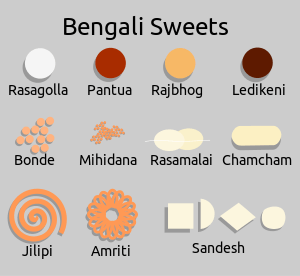
Yet another theory is that rasgulla was first prepared by someone else in Bengal, and Das only popularized it. In Banglar Khabar (1987), food historian Pranab Ray states that a man named Braja Moira had introduced rasgulla in his shop near Calcutta High Court in 1866, two years before Das started selling the dish.[31] In 1906, Panchana Bandopadhyay wrote that rasgullla was invented in the 19th century by Haradhan Moira, a Phulia-based sweetmaker who worked for the Pal Chowdhurys of Ranaghat.[32] According to Mistikatha, a newspaper published by West Bengal Sweetmeat Traders Association, many other people prepared similar sweets under different names such as gopalgolla (prepared by Gopal Moira of Burdwan district), jatingolla, bhabanigolla and rasugolla.[31] Food historian Michael Krondl states that irrespective of its origin, the rasgulla likely predates Nobin Chandra Das. A sales brochure of the company run by Das' descendants also hints at this: "it is hard to tell whether or not cruder versions of similar sweets existed anywhere at that time. Even if they did, they did not match the quality of Nobin Chandra, and having failed to excite the Bengali palate, they slipped into oblivion."[24]
Bhagwandas Bagla, a Marwari businessman and a customer of Nobin Chandra Das, popularized the Bengali rasgulla beyond the shop's locality by ordering huge amounts.[33]
Modern popularity
In 1930, the introduction of vacuum packing by Nobin Chandra's son Krishna Chandra Das led to the availability of canned Rasgullas, which made the dessert popular outside Kolkata, and subsequently, outside India.[34] Krishna Chandra's son Sarada Charan Das established the K.C. Das Pvt Ltd company in 1946.[35] Sarada Charan's younger, estranged son Debendra Nath established K.C. Das Grandsons in 1956.
Today, canned rasgullas are available throughout India, Pakistan and Bangladesh, as well as in South Asian grocery stores outside the subcontinent. In Nepal, Rasgulla became popular under the name Rasbari.[11]
The Indian space agency, ISRO is developing dehydrated rasgullas and other dishes for Indian astronauts in its planned manned mission in 2016.[36]
In 2015, the Odisha government initiated a move to get Geographical indication (GI) status for the rasagulla made in Pahala.[16] On 30 July, the people of Odisha celebrated "Rasagola Dibasa" ("Rasgulla Day") to reaffirm Odisha as the place of the dish's origin.[37] In August, West Bengal decided to legally contest Odisha's move to obtain GI Status.[23] In 2015 The odisha state government constituted three committees to claim over the Rasgulla . The committees submitted their interim report to the government. Noted journalist and food researcher Bhakta Tripathy and a member of the committee had submitted dossier containing historical evidence of Rasgulla origin in Odisha.[38] The Science and Technology department of the West Bengal government also started the process to get its own GI status for the dessert.[39]
Rasagola Dibasa
On July 30, 2015, on the day of "Niladri Bije", a social media campaign was started by using a hashtag #RasagolaDibasa and it later became a mainstream celebration as the maiden day to celebrate Rasgulla's origin to be Odisha. [9][37][40] Odia newspaper Sambad and FM Radio Radio Choklate in collaboration with the confectioners of Pahala celebrated a rasgulla exhibition-cum-awareness event in Bhubaneswar. Sand artist Sudarshan Patnaik made a sand sculpture in Puri Beach depicting "Niladri Bije" and Jagannath offering rasgulla to Lakshmi.[41]
It has been agreed upon to celebrate the Rasagola Dibasa every year on the tithi of Niladri Bije in the lunar calendar. In the year 2016, the Rasagola Dibasa has been celebrated on the 17th of July.[42]
Preparation
To prepare rasgulla, the cheese (chhena) mixture is formed into small balls. These balls are then simmered in a sugar syrup.[43] It can also be prepared using a pressure cooker[44] or an oven.[45] While serving add a drop of rose water (only organic and edible type of rose water, not rose perfume or synthetic flavors) to enhance the flavor and taste.
- Chhena divided into balls
- Chenna balls being boiled
- Rasgulla being taken out of the syrup
- Served with dry fruit toppings
Variations
The traditional Odisha rasgullas are softer and creamish in colour than Bengali rasgullas. The Bengali rasgullas are whitish and rubbery.[46]
The Pahal Rasagola from the Pahala area (located between the cities of Bhubaneswar and Cuttack) is also popular in India.[47]
- Bengali Rasgullas
 Reddish rasgullas from Pahala, Odisha
Reddish rasgullas from Pahala, Odisha Bikali Kar Rasagola from Salepur, Cuttack, Odisha
Bikali Kar Rasagola from Salepur, Cuttack, Odisha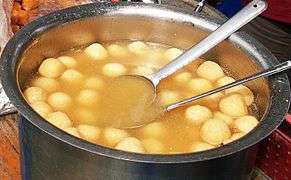 Rasagola from Bhubaneswar, Odisha
Rasagola from Bhubaneswar, Odisha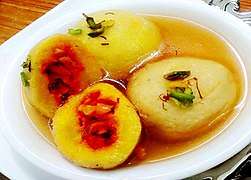 Rajbhog - variant of kesar rasgulla stuffed inside with dry fruits and khoa
Rajbhog - variant of kesar rasgulla stuffed inside with dry fruits and khoa Kamalabhog, an orange-flavoured Bengali rasgulla
Kamalabhog, an orange-flavoured Bengali rasgulla- Baked rasgulla - a Bengali variation
Derivatives and similar desserts
Along with chhena gaja and chhena poda, Rasgulla is one of three traditional Odia chhena desserts. Due to rasgulla becoming associated with the Bengali cuisine, the Odisha Milk Federation has tried to popularize chhena poda as the signature Odia dessert.[48][49]
Nutrition
Typically, a 100 gram serving of rasgulla contains 186 calories, out of which about 153 calories are in the form of carbohydrates. It also contains about 1.85 grams of fat and 4 grams of protein.[50]
Geographical Indication (GI) tag
In 2015, West Bengal applied for a Geographical Indication (GI) status for "Banglar Rasogolla" (Bengali Rasgulla). The Government clarified that there was no conflict with Odisha, and its application was only for a specific variant which was different in "both in colour, texture, taste, juice content and method of manufacturing" from the variant produced in Odisha.[3] On 14 November 2017, the GI Registry of India granted West Bengal the GI status for Banglar Rasogolla.[4][51][52]
A tweet about the news by the West Bengal Chief Minister Mamta Banerjee was projected as if the debate about the sweet's origin had been settled in favour of West Bengal. However, the GI tag was granted only for Banglar Rasogolla, a term that refers only to the sweet produced in West Bengal.
The GI Registrar office at Chennai later specifically clarified that West Bengal was given GI status only for the Bengali version of Rasgulla ("Banglar Rasogolla"), not for the sweet's origin. The office also stated that Odisha had not by then applied for any GI tag, but it could also get Rasgulla's GI tag by presenting the necessary evidence.[4]
See also
| Wikibooks Cookbook has a recipe/module on |
References
- ↑ "Panel seal on rasgulla's Odisha origin". Retrieved 2016-10-02.
- ↑ Sarat Chandra Mahapatra (1994). Car Festival of Lord Jagannath, Puri. Puri: Sri Jagannath Research Centre. p. 149. OCLC 967072714.
- 1 2 "Our Claim Only On A Variety Of Rasogolla, No Dispute With Odisha: West Bengal". NDTV. Press Trust Of India. 27 July 2016. Retrieved 24 August 2016.
- 1 2 3 "Sweet War: This GI tag is for Banglar Rosogolla, it is not about the origin". The New Indian Express. 14 November 2017.
- ↑ "Rasgulla@Oxford Dictionaries" (in Hindi). India: Oxford University Press. Retrieved 28 August 2015.
- ↑ Deepika Sahu (2 July 2012). "Discover Odisha's 'sweet' magic". The Times of India.
- ↑ "History of rossogolla now just a click away". The Times of India. 15 March 2013.
- ↑ "Of luchi, rolls & roshogolla in Durga puja". Daily Bhaskar. 29 September 2011.
- 1 2 "Rasagola originated in Odisha- Did you know?". Zee News. 30 July 2015.
- ↑ Sonali Pattnaik (18 July 2013). "How to make…Rasagolla". The Hindu.
- 1 2 Alan Davidson (21 September 2006). The Oxford Companion to Food. OUP Oxford. p. 1880. ISBN 978-0-19-101825-1.
- 1 2 Mitra Bishwabijoy (6 July 2015). "Who invented the rasgulla?". Times of India. Retrieved 2 August 2015.
- ↑ "Trinity take 'adhar pana' on raths". The New Indian Express. 5 July 2009.
- ↑ Subhashish Mohanty (3 July 2012). "Lord placates wife with sweet delight".
- ↑ "Sweet and sermon return for deities". The Telegraph. Calcutta. 26 July 2010.
- 1 2 3 4 Mohapatra Bhattacharya; Debabrata Kajari (31 July 2015). "Citing Rath ritual, Odisha lays claim to rasagulla, WB historians don't agree". Times of India. Retrieved 1 August 2015.
- ↑ Jagabandhu Padhi (2000). Sri Jagannatha at Puri. S.G.N. Publications.
- ↑ Sarat Chandra Mahapatra (1994). Car Festival of Lord Jagannath, Puri. Puri: Sri Jagannath Research Centre. p. 55. OCLC 967072714.
- ↑ Debabrata Mohapatra (29 July 2007). "Researchers Claim Rasgullas Were Born In Puri". The Times of India.
- ↑ Madhulika Dash (11 September 2014). "The Food Story: How India's favourite sweet dish rosugulla was born". Indian Express.
- ↑ Michael Krondl (Summer 2010). "The Sweetshops of Kolkata". Gastronomica. 10 (3): 58–65. doi:10.1525/gfc.2010.10.3.58.
- ↑ Shoaib Daniyal (4 August 2015). "Who Deserves Credit For The Rasgulla? Bengalis, Odiyas...Or The Portuguese?". Kashmir Observer. Archived from the original on 9 October 2015.
- 1 2 Jhimli Mukherjee Pandey (10 August 2015). "Maharashtra (West Bengal) takes up rosogolla battle with Odisha". The Times of India.
- 1 2 Michael Krondl (2011). Sweet Invention: A History of Dessert. Chicago Review Press. pp. 55–59. ISBN 978-1-55652-954-2.
- ↑ "Hopes for Rasagola Origin in Odisha Revived". The Pioneer. 15 July 2016. Retrieved 20 July 2016.
- ↑ Ramayana, Jagamohan. Ramayana. Ajodhya Kanda: Balaram Das.
- ↑ Typical selections from Oriya Literature. Ramayana. B.C. Mazumdar. p. 84.
- ↑ Purnachandra Bhasakosha (1931–1940). Chalha. G. C. Praharaj. p. 2594. Retrieved 20 July 2016.
- ↑ Subodh Chandra, Sengupta, ed. (1976). Samsad Bangla Charitabhidhan (1st ed.). Kolkata: Sahitya Samsad. p. 240. Retrieved February 23, 2018.
- ↑ Sankar Ray (31 July 2011). "Where is the creativity that gave us the Rosogolla?". DNA.
- 1 2 Ishita Dey (2015). Michael Krondl; et al., eds. The Oxford Companion to Sugar and Sweets. Oxford University Press. pp. 580–581. ISBN 978-0-19-931361-7.
- ↑ "The sweet legacy of Durga Puja". The Times of India. 29 September 2014.
- ↑ "How the rasogolla became a global name!". rediff.com. 16 November 2011.
- ↑ Piyasree Dasgupta (29 October 2011). "Sticky Sweet Success". Indian Express.
- ↑ Bishwanath Ghosh (29 October 2014). Longing, Belonging: An Outsider At Home In Calcutta. Westland. p. 177. ISBN 978-93-84030-60-5.
- ↑ Ram Kumar Ramaswamy (16 June 2012). "Isro astronauts to savour idlis, rasgullas in space". Asian Age.
- 1 2 Ramani Ranjan Mohapatra (30 July 2015). "#RasagolaDibasa trends as Odias reclaim iconic dish". Hindustan Times.
- ↑ Sweet Struggle- Origin of Rasgulla Archived 18 August 2016 at the Wayback Machine.
- ↑ "West Bengal and Odisha Battle Over the Invention of 'Rasgulla'". NDTV. 26 August 2015.
- ↑ Dhrubo Jyoti (30 July 2015). "Revenge is sweet: How Bengalis made rosogolla their own". Retrieved 2 August 2015.
- ↑ "Odisha celebrates 'Rasagola Dibasa' with great fanfare". 31 July 2015. Retrieved 2 August 2015.
- ↑ "Odisha celebrates 'Rasagola Dibasa', state claims evidence of origin - Times of India". Retrieved 2016-07-21.
- ↑ Lois Sinaiko Webb (1 January 2000). Multicultural Cookbook of Life-cycle Celebrations. ABC-CLIO. pp. 309–. ISBN 978-1-57356-290-4.
- ↑ Tarla Dalal (17 November 2003). Desserts Under Ten Minutes. Sanjay & Co. pp. 69–. ISBN 978-81-86469-84-2.
- ↑ Tarla Dalal (2006). Low Calorie Sweets. Sanjay & Co. pp. 42–. ISBN 978-81-89491-34-5.
- ↑ "The Sweet Bypass on NH-5". Upper Crust. Retrieved 20 March 2014.
- ↑ Rimli Sengupta (9 January 2012). "Kling Canoes At Tamralipta". Outlook.
- ↑ Rajaram Satapathy (15 August 2002). "Sweet wars: Chhenapoda Vs rasagolla". The Times of India.
- ↑ "Chew on This: Chenna poda". Metro Plus Kochi. The Hindu. 11 April 2009.
- ↑ Nutrition Information For Rasgulla. Livestrong.Com. Retrieved on 6 December 2012.
- ↑ "Intellectual Property India". ipindiaservices.gov.in. Retrieved 2017-11-15.
- ↑ "Certificate of Registration of Geographical Indication under section 16 (1)-or of authotised user under section 17(3)(e)" (PDF). Intellectual Property India. 2017-11-14. Retrieved 2017-11-15.
